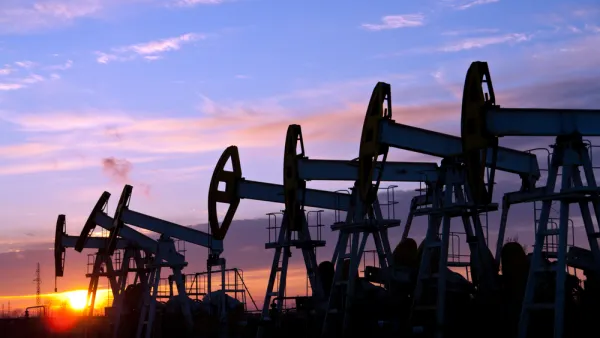So much for the economic laws of supply and demand or "drilling our way" to cheap gas prices. It's not that simple when it comes to oil. Dan Strumpf explains what's behind the latest surge in oil prices. Oil markets and infrastructure play key roles.
It's well known that the U.S. is experiencing an unprecedented boom in oil production due primarily to hydraulic fracturing of shale basins in Texas and North Dakota which doubled and tripled production, respectively, since 2010 according to the Energy Information Administration (EIA). By 2020, the U.S. should overtake Saudi Arabia as the world's top producer, the Paris-based International Energy Agency reported last November.
Only more recently has light been shed on the lack of infrastructure to take all this new oil to refineries. Lesser known is how the price differentials between the two oil markets for trading oil, the U.S. benchmark West Texas Intermediate (WTI) and the global crude-market benchmark, North Sea Brent, affect what motorists pay at the pump.
The spread, which was more than $23 per barrel ($/bbl) in mid-February, fell to under $9/bbl in April, and has ranged between $6/bbl and $10/bbl since then. [EIA, June 28, 2013]
The glut of domestic oil that had trouble finding its way to refineries caused the WTI price to lag well behind Brent which in turn affects oils futures prices on the New York Mercantile Exchange (Nymex). The price difference was as great as $28 in October, 2011. But that's changed now, as infrastructure, while still lagging, has begun to catch up, reducing stockpiles of oil which in turn affects oil prices in the U.S..
The jump in prices (in mid-July) was sparked by data showing a bigger-than-expected drop in U.S. crude-oil supplies last week, according to the federal EIA. Several recently opened pipelines and rail routes are helping oil companies tap into the huge pool of supplies that were previously trapped in the middle of the country.
Increased oil delivery to Gulf refineries means they are churning out increased refined petroleum products, e.g. diesel and gasoline, much of which is being exported where demand is indeed increasing.
Now, money managers with bets on U.S. oil prices once again have to contend with the appetite for gasoline and diesel around the world, and especially in emerging markets. The oil that was trapped in and around Cushing, Okla., a key storage hub, is flowing more or less freely to the Gulf Coast, where refiners are taking it, processing it and shipping it overseas in increasing volumes.
The price gap has changed rapidly. On July 10, the date Strumpf wrote his article, oil was priced at $106; $2 less than Brent. Reuters reported on July 19 that not only had the gap closed, but that "U.S. oil futures traded above the global crude-market benchmark, North Sea Brent, for the first time since 2010 as signs of strong demand from U.S. refiners boosted spread trading and bets that the era of the U.S. discount was ending." The closing price on July 19 for WTI was "near a 16-month high above $108, while Brent settled lower."
FULL STORY: U.S. Oil Soars Above $106 to 15-Month High

Analysis: Cybertruck Fatality Rate Far Exceeds That of Ford Pinto
The Tesla Cybertruck was recalled seven times last year.

National Parks Layoffs Will Cause Communities to Lose Billions
Thousands of essential park workers were laid off this week, just before the busy spring break season.

Retro-silient?: America’s First “Eco-burb,” The Woodlands Turns 50
A master-planned community north of Houston offers lessons on green infrastructure and resilient design, but falls short of its founder’s lofty affordability and walkability goals.

Test News Post 1
This is a summary

Analysis: Cybertruck Fatality Rate Far Exceeds That of Ford Pinto
The Tesla Cybertruck was recalled seven times last year.

Test News Headline 46
Test for the image on the front page.
Urban Design for Planners 1: Software Tools
This six-course series explores essential urban design concepts using open source software and equips planners with the tools they need to participate fully in the urban design process.
Planning for Universal Design
Learn the tools for implementing Universal Design in planning regulations.
EMC Planning Group, Inc.
Planetizen
Planetizen
Mpact (formerly Rail~Volution)
Great Falls Development Authority, Inc.
HUDs Office of Policy Development and Research
NYU Wagner Graduate School of Public Service


























